TL;DR:
- Using technology to enhance thinking routines transforms students from consumers of information to creators, as they share their thinking visually.
- Technology tools such as Padlet, Pear Deck, Flipgrid, and Google Slides can help students synthesize their thoughts to make their thinking visible.
During the 2018-19 school year, my administration at the time introduced the staff to thinking routines. Thinking routines are “designed to promote students’ thinking, such as asking students what they know, what they want to know, and what they have learned as part of a unit of study.” They take what students have read and have them synthesize their thoughts to make their thinking visible.
At first, I just thought they were glorified graphic organizers; however, that is not the case. Instead, they are structures that take students from consuming to creating by sharing their ideas in a visible manner.
Power Up Thinking Routines
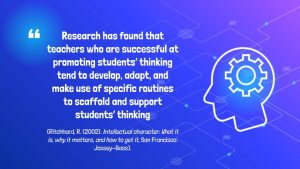
There are so many thinking routines and they all have different purposes. Some facilitate understanding and creativity, while others focus on fairness and truth. In the past few years, the Project Zero’s Thinking Routines Toolbox that houses these routines has grown exponentially.
On their own, these routines are powerhouses that provide students with structures to help reveal their thinking. But when we amplify these thinking routines using technology tools, we truly provide our students with ways to “think better” and share that thinking.
So what are some ways that we can partner up these two amazing strategies? There are a variety of programs out there that truly promote sharing our students’ voices and by doing so, they are perfect partners for thinking routines.
When you take these thinking routines and partner them up with technology tools, you truly amplify not only your students' thinking, but the impact of the routines. Share on XPartnering Up With Padlet
Padlet is a prime candidate for partnering with thinking routines. Padlet is a virtual wall where students can post their ideas. On this digital bulletin board, students can share their thinking with the rest of their learning community in a safe forum. Padlet has a variety of formats to do this.
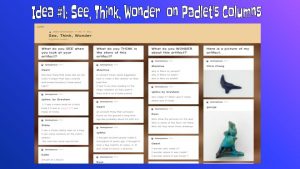
See, Think, Wonder Thinking Routine on Padlet
One of my favorites is Padlet’s columns format. This format is ideal for thinking routines such as See, Think, Wonder. This past spring, my third grade students used Padlet as they examined artifacts on Smithsonian Learning Lab from ancient Egypt. Each student got the opportunity to share what they saw looking at the artifact, what they thought the story behind the artifact was, and what they wondered about the artifact.
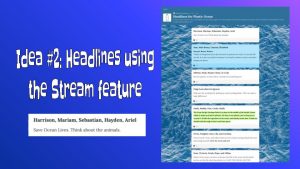
Headlines Thinking Routine on Padlet
Another favorite Padlet format is the Stream feature. The stream feature creates a mock social media feed where students can share responses, plus they can react and respond to classmates’ responses. This format works well with the Headlines thinking routine. The Headlines thinking routine asks students to create a headline that encapsulates the main idea of what they have learned. During the 2019-2020 school year, my fifth graders used this strategy after watching two videos on EdPuzzle about the impact of plastic in the ocean. Students created headlines collaboratively in groups and then were able to see their classmates’ responses too.
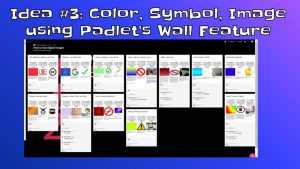
Color, Symbol, Image Thinking Routine on Padlet
Padlet’s wall feature also works well with thinking routines. This feature acts like a bulletin board where students can post their work online to share. This format corresponds nicely with the Color, Symbol, Image routine. In this routine, students identify a color, a symbol, and an image that represent their understanding of a topic and explain their choices. In the 2019-2020 school year, my sixth grade students used this format to share what they had learned about using digital images correctly. They loved getting to see each other’s choices and comment on them.
Pear Deck and Thinking Routines: The Perfect Pair
I love Pear Deck and not just because I am a regional Virginia Pear Deck coach. I love it because it takes any Google slides presentation and makes it interactive using a variety of different slide types. All students get the opportunity to share their thinking and teachers can not only give feedback to their students in real time, but display student work anonymously to validate student thinking as a class.
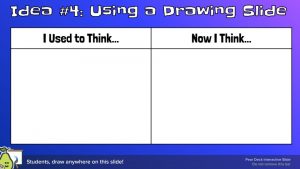
I Used to Think and Now I Think Thinking Routine on Pear Deck
One of my favorite ways to use Pear Deck is the drawing slide. The drawing slide allows students to share their thoughts in either words or pictures. This works really well with the I Used to Think…Now I Think thinking routine. Using this perfect pair, every student gets a chance to share their thinking, and teachers provide students with both choice and voice in how they express their responses.
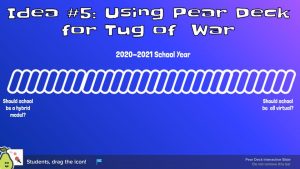
Tug of War Thinking Routine on Pear Deck
Another great way to use Pear Deck is using a combination of the draggable and text slide types. The draggable slide is ideal for the Tug of War thinking routine. In this routine, students need to determine where they stand on an issue. In a classroom environment, this allows students to select their stance and not be persuaded by their peers. The text slide then gives each student an opportunity to share why they selected the location on the rope that they did.
Flipgrid Fever and Thinking Routines
If you haven’t explored Flipgrid yet, start now. Flipgrid is an engaging cloud-based video discussion platform that gives all of your students a place to share their thinking. All students get to create their own videos to share their thoughts and respond to each other’s comments. Students get to do so with many options including a whiteboard, blackboard, and screen recording features. They can also add words and stickers to complement their videos.
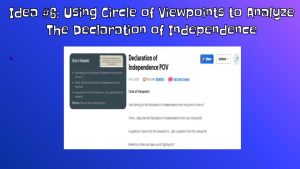
Circle of Viewpoints Thinking Routine on Flipgrid
This past year, while coteaching in one of my fourth grade classes, students used the thinking routine Circle of Viewpoints to analyze the Declaration of Independence. Each student created a short video from the viewpoint of either a British soldier, a female colonist, or a slave, and shared their perspective on the Declaration of Independence. Not only did this help students to better understand the impact of the Declaration of Independence, but this allowed them to develop a culturally responsive mindset.
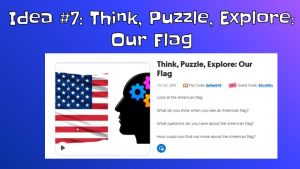
Think, Puzzle, Explore Thinking Routine on Flipgrid
But don’t think that thinking routines are just for upper elementary students. During the 2019-2020 school year, my kindergarten students used Flipgrid for the Think, Puzzle, Explore thinking routine. Each student created a short video sharing what they thought about when looking at the American flag, what questions they had about the flag, and how they could learn more about our flag.
[scroll down to keep reading]
Let’s Slide Google Tools and Thinking Routines Together
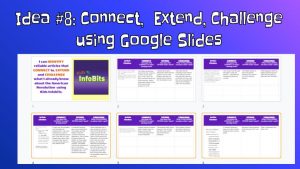
Connect, Extend, Challenge Thinking Routines using Google Slides
Two of the Google Suite for Education tools that can be used with thinking routines are Google Slides and Google Draw. While coteaching in one of my fourth grade classes, we used the thinking routine Connect, Extend, Challenge while researching the American Revolution using a database called Kids InfoBits. Each student was assigned one slide to record what they connected to in these articles, how these articles extended what they knew, and what lingering questions they had. This activity could have easily been done in Google Draw as well.
As you can see, when you take these thinking routines and partner them up with technology tools, you truly amplify not only your students’ thinking, but the impact of the routines. Technology’s greatest gift is to provide students with new and unique opportunities that they couldn’t have without these tools. Help your students “think better” and give these partnerships a try.
ABOUT DEBBIE TANNENBAUM
Debbie Tannenbaum is an Elementary School Technology Specialist in Fairfax County, VA. An educator with over twenty years of experience, Mrs. Tannenbaum is completing her second year in this role, where she supports both staff and students to integrate technology tools into instruction through both co-teaching sessions and weekly technology classes. Mrs. Tannenbaum is also an avid blogger and shares her thoughts and reflections on her website: Techy Notes. You can also find her on Twitter and Instagram at @TannenbaumTech.


